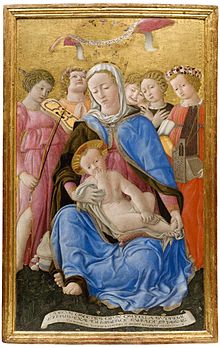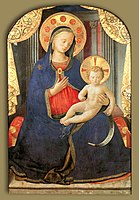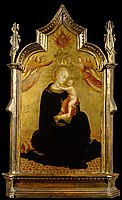Madonna of humility

Madonna of humility refers to artistic portrayals of the Virgin Mary which depict her as a Madonna sitting on the ground, or sitting upon a low cushion. She may be holding the Child Jesus in her lap.[1] The term Virgin of humility is also used to refer to this style of depiction.
The iconography originated in the 14th century, and was most common in that and the following century.
History and development[]
Humility was a virtue extolled by Saint Francis of Assisi, and this style of image was associated with Franciscan piety, although it was not the creation of the Franciscans since the artist first associated with the image, Simone Martini, had ties with the Dominicans and may have created the image for them.[2] The word humility derives from the Latin humus, meaning earth or ground.[3][4]
The earliest known painting of this type dates to 1346 and is at the Museo Nazionale in Palermo, Sicily. It represents a Madonna seated on a small cushion just above the ground. The Child Jesus that she holds partially looks at the viewer. The painting bears the inscription Nostra Domina de Humiltate, with the low cushion intended to express her humility. This painting in Palermo is, however, of a somewhat mediocre quality and was perhaps based on a work of Simone Martini. A similar painting in the Gemäldegalerie, Berlin,[5] and both paintings were probably based on a Madonna of humility by Martini.[6] A Virgin of humility fresco by Simone Martini survives in the Palais des Papes in Avignon, France.[7]
An altar was dedicated to the Madonna of humility in the church of Santa Maria Novella in Florence in 1361.[8] This style of painting spread quickly through Italy and by 1375 examples began to appear in Spain, France and Germany. It was the most popular among the depictions of the early Trecento artistic period.[6]
Examples[]

Domenico di Bartolo's Madonna of Humility, painted in 1433, was described by art historian Andrew Ladis as one of the most innovative devotional images of the early Renaissance.[9] The formal symmetry of the strips below her feet and those hovering above her symbolize the harmony of her human nature and status as an earthly woman, with her heavenly queenship. Despite the low seating position, the star and the gems as well as the halo signify her regal status.[9] In this painting, which is at the Pinoteca Nazionale in Siena, Domenico did not use cast shadows as he did in other works such as the Madonna Enthroned.[10]
Filippo Lippi's Madonna of Humility, painted between 1431 and 1437, is also an important work and illustrates Lippi's early style, when he was attentive to Masaccio's use of large and round figures. It was painted during a period when Lippi had dropped out of sight, and had perhaps gone into exile with Cosimo de' Medici.[11]
A miracle attributed to the fresco of the Madonna of Humility painted in circa 1370 gave rise to the construction of the Basilica of Our Lady of Humility in Pistoia, Tuscany, Italy. The fresco is sometimes attributed to Giovanni di Bartolomeo Cristiani, but was perhaps done by a local painter from Pistoia.[12] The Basilica, built by architect Ventura Vitoni, is an important example of high Renaissance architecture. Giorgio Vasari built the octagonal dome atop the Basilica in 1562. The original fresco remains within the Basilica.[13]
Other key examples include Bernardo Daddi's central panel in the De Carlo Triptych in which the Madonna is shown sitting in a very low chair, rather than on a cushion.[14] Fra Angelico's representation of about 1430 (which includes two angels) is notable in that Jesus is approached from above, focusing on his divinity.[15] Giovanni di Paolo's depiction of about 1456 (see gallery below) represents a transition in the perception of nature, with the visual landscape forming itself around the seated Madonna.[16]
Feast[]
The Humility of the Blessed Virgin Mary is celebrated with a feast on July 17.[17][18][19] This feast was included in the General Roman Calendar of 1954 in Feasts pro Aliquibus Locis (in some places), but was removed from the General Roman Calendar of 1960. It continues to be privately observed by some Catholics and Franciscans.[citation needed]

In his homily for the Solemnity of All Saints, November 1, 2000, Pope John Paul II spoke at length on Mary's humility:
The depth of the Blessed Virgin's faith in God's word appears clearly in the song of the Magnificat: "My soul magnifies the Lord, / and my spirit rejoices in God my Saviour, / for he has regarded the low estate of his handmaiden" (Lk 1: 46-48).
In this song Mary shows what constituted the foundation of her holiness: deep humility. We might ask ourselves in what did her humility consist. Much is said to us by the "trouble" she felt at the Angel's greeting: "Hail, full of grace, the Lord is with you" (Lk 1: 28). Before the mystery of grace, the experience of a particular presence of God who has rested his gaze upon her, Mary feels a natural impulse of humility (literally, of "abasement"). It is the reaction of someone who is fully aware of her own littleness before the greatness of God. In the truth Mary beholds herself, others and the world.
Was not the sign of humility the question: "How can this be, since I have no husband?" (Lk 1: 34). She had just heard that she was to conceive and bear a child, who would reign on the throne of David as the Son of the Most High. Certainly, she did not fully understand the mystery of that divine plan, but she realized that it meant a total change in the reality of her life. However, she did not ask: will this really happen? must this happen? She simply said: how can this be? With no doubts or reservations, she accepted the divine intervention that changed her life. The question expressed the humility of faith, the willingness to put one's life at the service of the divine mystery, without being able to understand how it would come about.
This humility of spirit, this complete submission in faith, is particularly expressed in her "fiat": "Behold, I am the handmaid of the Lord; let it be to me according to your word" (Lk 1: 38). Because of Mary's humility, what she would later sing in the Magnificat could be fulfilled: "Henceforth all generations will call me blessed; / for he who is mighty has done great things for me, / and holy is his name" (Lk 1: 48-49).
The greatness of the gift corresponds to the depth of the humility. He who is mighty did "great things" for her (cf. Lk 1: 49), and she knew how to accept them with gratitude and to hand them on to all generations of believers. This is the way to heaven followed by Mary, Mother of the Saviour, who goes ahead of all the Church's saints and blesseds on this path.[20]
Upon the election of Pope Francis in 2013, Russian Orthodox Bishop Hilarion Alfeyev gifted an icon of Our Lady of Humility, which the Roman Pontiff accepted; then donated to Pope Emeritus Benedict XVI during their farewell meeting at Castel Gandolfo.[21]
Gallery[]

Fra Angelico, c. 1430.

Lorenzo Monaco, c. 1410

Sano di Pietro c. 1440

Andrea di Bartolo, c. 1410

Sassetta, ca. 1445–1450

Giovanni di Paolo, c. 1456
See also[]
| Wikimedia Commons has media related to Madonna of humility. |
References[]
| Part of a series on the |
| Mariology of the Catholic Church |
|---|
 |
|
|
- ^ Renaissance art: a topical dictionary by Irene Earls 1987 ISBN 0-313-24658-0 page 174
- ^ Williamson, Beth (2009). The Madonna of Humility. Boydell and Brewer. p. 115.
- ^ A history of ideas and images in Italian art by James Hall 1983 ISBN 0-06-433317-5 page 223
- ^ Iconography of Christian Art by Gertrud Schiller, 1971 ASIN: B0023VMZMA page 112
- ^ Cat. # 1072, "Follower of Lippo Memmi per the 1986 catalogue.
- ^ a b Painting in Florence and Siena after the Black Death by Millard Meiss 1979 ISBN 0-691-00312-2 pages 132-133
- ^ Provence, 4th by Dana Facaros, Michael Pauls 2004 ISBN 1-86011-175-0 page 94
- ^ Painting in Florence and Siena after the Black Death by Millard Meiss 1979 ISBN 0-691-00312-2 page 144
- ^ a b Art and music in the early modern period by Franca Trinchieri Camiz, Katherine A. McIver ISBN 0-7546-0689-9 page 15 [1]
- ^ Sassetta: the Borgo San Sepolcro altarpiece, Volume by James R. Banker, Machtelt Israėls 2009 ISBN 0-674-03523-2 page 309 [2]
- ^ Humanists and Reformers: A History of the Renaissance and Reformation by Bard Thompson 1996 ISBN 0-8028-6348-5 page 249
- ^ Painting in Florence and Siena after the Black Death by Millard Meiss 1979 ISBN 0-691-00312-2 pages 136
- ^ The Christian Travelers Guide to Italy by David Bershad, Carolina Mangone, Irving Hexham 2001 ISBN 0-310-22573-6 page [3]
- ^ The fourteenth century. Bernardo Daddi and his circle by Richard Offner, Miklós Boskovits 2002 ISBN 88-09-02182-7 page 21 [4]
- ^ Jesus of History, Christ of Faith by Thomas Zanzig 2000 ISBN 0-88489-530-0 page 306 [5]
- ^ Man in the Landscape: A Historic View of the Esthetics of Nature by Paul Shepard, Dave Foreman 2002 ISBN 0-8203-2440-X page 170 [6]
- ^ "July 17th: Humility of the Blessed Virgin Mary". Retrieved July 17, 2021.
{{cite web}}: CS1 maint: url-status (link) - ^ Peterson, Larry (July 27, 2018). "The Humility of the Blessed Virgin Mary; This was Her defining Virtue". Catholic 365. Retrieved July 17, 2021.
{{cite web}}: CS1 maint: url-status (link) - ^ Lovasik, S.V.D., Rev. Lawrence G. "Our Lady's Feast Days". EWTN. Retrieved July 17, 2021.
{{cite web}}: CS1 maint: url-status (link) - ^ John Paul II, Pope (November 1, 2000). "Solemnity of All Saints: Homily of John Paul II". The Vatican. Retrieved July 17, 2021.
{{cite web}}: CS1 maint: url-status (link) - ^ Rembrandt's faith by Shelley Karen Perlove, Larry Silver 2009 ISBN 0-271-03406-8 page 175
Further reading[]
- Williamson, Beth, Madonna of Humility: Development, Dissemination and Reception, c. 1340-1400 (Woodbridge, Suffolk: Boydell Press, 2009) (Bristol Studies in Medieval Cultures, 1).
- Virgin Mary in art





